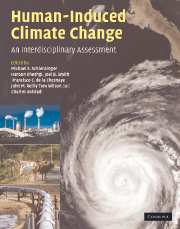Book contents
- Frontmatter
- Contents
- List of contributors
- Preface
- Part I Climate system science
- Part II Impacts and adaptation
- 9 Dynamic forecasts of the sectoral impacts of climate change
- 10 Assessing impacts and responses to global-mean sea-level rise
- 11 Developments in health models for integrated assessments
- 12 The impact of climate change on tourism and recreation
- 13 Using adaptive capacity to gain access to the decision-intensive ministries
- 14 The impacts of climate change on Africa
- Part III Mitigation of greenhouse gases
- Part IV Policy design and decisionmaking under uncertainty
- Index
- Plate section
- References
10 - Assessing impacts and responses to global-mean sea-level rise
from Part II - Impacts and adaptation
Published online by Cambridge University Press: 06 December 2010
- Frontmatter
- Contents
- List of contributors
- Preface
- Part I Climate system science
- Part II Impacts and adaptation
- 9 Dynamic forecasts of the sectoral impacts of climate change
- 10 Assessing impacts and responses to global-mean sea-level rise
- 11 Developments in health models for integrated assessments
- 12 The impact of climate change on tourism and recreation
- 13 Using adaptive capacity to gain access to the decision-intensive ministries
- 14 The impacts of climate change on Africa
- Part III Mitigation of greenhouse gases
- Part IV Policy design and decisionmaking under uncertainty
- Index
- Plate section
- References
Summary
Introduction
One of the more certain impacts of human-induced climate change is a rise in global-mean sea level (Nicholls and Lowe, 2004). While the impacts of this sea-level rise are confined to coastal areas, these include the most densely populated land areas on Earth and they support important and productive ecosystems that are sensitive to sea-level change. Further, coasts are also experiencing significant human-induced modification, so sea-level rise and climate change are an additional stress, which amplifies their impacts (Bijlsma, 1996; Kremer et al., 2005).
During the twenty-first century, global-mean sea-level rise will likely be less than 1 metre (Church and Gregory, 2001), but still potentially directly affecting at least 200 million people based on 1990 population (Hoozemans et al., 1993; Mimura, 2000). Over the longer term (many centuries), a much larger sea-level rise exceeding 10 m is possible under some emission pathways owing to ablation of the Greenland Ice Sheet and collapse of the West Antarctic Ice Sheet, among other changes (Oppenheimer and Alley, 2004; Nicholls and Lowe, 2005). Further, the high human exposure to sea-level rise is increasing rapidly because of global population growth and coastward migration. Therefore, any global assessment of the climate change issue must include the coastal implications.
A fundamental result that has long been recognized by climate scientists, but less considered by policy, is that irrespective of future greenhouse gas emissions, there is a “commitment to sea-level rise” (Nicholls and Lowe, 2004; 2005).
- Type
- Chapter
- Information
- Human-Induced Climate ChangeAn Interdisciplinary Assessment, pp. 119 - 134Publisher: Cambridge University PressPrint publication year: 2007
References
- 3
- Cited by



